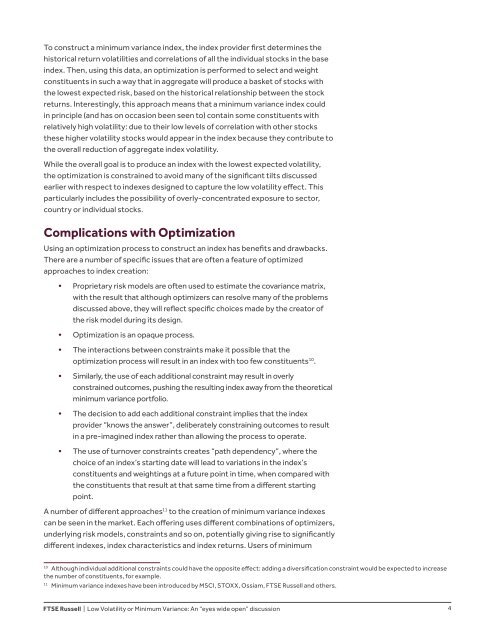Low Volatility or Minimum Variance
Low-Vol-Whitepaper
Low-Vol-Whitepaper
Create successful ePaper yourself
Turn your PDF publications into a flip-book with our unique Google optimized e-Paper software.
To construct a minimum variance index, the index provider first determines the<br />
hist<strong>or</strong>ical return volatilities and c<strong>or</strong>relations of all the individual stocks in the base<br />
index. Then, using this data, an optimization is perf<strong>or</strong>med to select and weight<br />
constituents in such a way that in aggregate will produce a basket of stocks with<br />
the lowest expected risk, based on the hist<strong>or</strong>ical relationship between the stock<br />
returns. Interestingly, this approach means that a minimum variance index could<br />
in principle (and has on occasion been seen to) contain some constituents with<br />
relatively high volatility: due to their low levels of c<strong>or</strong>relation with other stocks<br />
these higher volatility stocks would appear in the index because they contribute to<br />
the overall reduction of aggregate index volatility.<br />
While the overall goal is to produce an index with the lowest expected volatility,<br />
the optimization is constrained to avoid many of the significant tilts discussed<br />
earlier with respect to indexes designed to capture the low volatility effect. This<br />
particularly includes the possibility of overly-concentrated exposure to sect<strong>or</strong>,<br />
country <strong>or</strong> individual stocks.<br />
Complications with Optimization<br />
Using an optimization process to construct an index has benefits and drawbacks.<br />
There are a number of specific issues that are often a feature of optimized<br />
approaches to index creation:<br />
••<br />
Proprietary risk models are often used to estimate the covariance matrix,<br />
with the result that although optimizers can resolve many of the problems<br />
discussed above, they will reflect specific choices made by the creat<strong>or</strong> of<br />
the risk model during its design.<br />
••<br />
Optimization is an opaque process.<br />
••<br />
The interactions between constraints make it possible that the<br />
optimization process will result in an index with too few constituents 10 .<br />
••<br />
Similarly, the use of each additional constraint may result in overly<br />
constrained outcomes, pushing the resulting index away from the the<strong>or</strong>etical<br />
minimum variance p<strong>or</strong>tfolio.<br />
••<br />
The decision to add each additional constraint implies that the index<br />
provider “knows the answer”, deliberately constraining outcomes to result<br />
in a pre-imagined index rather than allowing the process to operate.<br />
••<br />
The use of turnover constraints creates “path dependency”, where the<br />
choice of an index’s starting date will lead to variations in the index’s<br />
constituents and weightings at a future point in time, when compared with<br />
the constituents that result at that same time from a different starting<br />
point.<br />
A number of different approaches 11 to the creation of minimum variance indexes<br />
can be seen in the market. Each offering uses different combinations of optimizers,<br />
underlying risk models, constraints and so on, potentially giving rise to significantly<br />
different indexes, index characteristics and index returns. Users of minimum<br />
10<br />
Although individual additional constraints could have the opposite effect: adding a diversification constraint would be expected to increase<br />
the number of constituents, f<strong>or</strong> example.<br />
11<br />
<strong>Minimum</strong> variance indexes have been introduced by MSCI, STOXX, Ossiam, FTSE Russell and others.<br />
FTSE Russell | <strong>Low</strong> <strong>Volatility</strong> <strong>or</strong> <strong>Minimum</strong> <strong>Variance</strong>: An “eyes wide open” discussion 4



